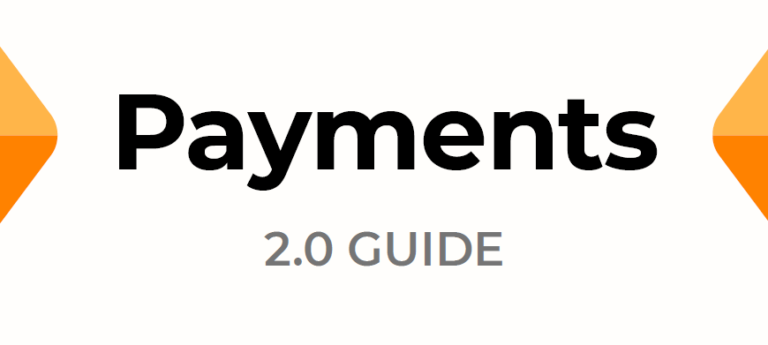The way consumers interact with money—save it, spend it, and borrow it—is rapidly changing as advancing technology enhances the digital banking experience. Cashless transactions are growing in popularity and the digital payments market is quickly expanding to offer more options than ever before —creating opportunities for third-party fintechs to swoop in and take advantage.
They aren’t the only ones scrambling to offer new payment avenues to tech-hungry consumers, though. Banking giants like JPMorgan Chase and Capital One are expanding payments services to keep up. Credit unions may fall behind quickly if they don’t proactive pursue payment capabilities.
Unfortunately, credit unions are typically tight on resources. The capital, the tech support, and the in-house talent needed to create tech solutions means that the best way to get competitive technology is to partner with fintechs.
Download the full PDF of this guide here.
Payments Trends and Statistics
From digital transformation initiatives, changes in consumer behavior throughout the pandemic, and the effects of an economic downturn, the payments industry is ripe for disruption. Unfortunately, disruption often comes from outsiders that cut into the market share of traditional financial institutions.
Credit unions are losing the payments game to fintechs, but they’re not alone—banks are feeling the squeeze, too. Here’s where payments trends are moving:
- Small businesses and payment processing are key. On average, between 13–35% of accounts are small businesses, yet Square handles payment processing for more small businesses than Chase, Wells Fargo, Citi Bank, Bank of America, and PNC combined. The market for business payments is huge, yet traditional financial institutions aren’t meeting the demand. Consequently, through 2020, traditional financial institutions lost $250b in payment volume to competitors.
- It’s not just processing—it’s everything. Fintechs are taking market share bit by bit, from cryptocurrencies, to mobile payments, to Buy Now, Pay Later (BNPL). As competition for all payments increase, capturing and maintaining share of wallet is increasingly important, making loyalty and rewards programs more necessary than ever.
- Credit union members are expanding payment methods faster than non-members. The PSCU Eye on Payments report shows that all respondents to a poll used more payment methods than they did a few years ago. It also founds that credit union members were almost 16% more likely to have used more payment methods in that time period, which means more crypto exchanges, BNPL providers, mobile and merchant apps, P2P platforms, fintech cards, and more. If your credit union hasn’t offered these options, then most members—yes, most—are sending their dollars through your competitor’s rails.
Partnering with Payments Fintechs
Offering in-demand payment services will prevent members from finding those services elsewhere. It may even offer incentives for new members to join.
Competitors often offer additional financial services with their payments options (like checking, savings, or loan products), further eating credit union market share. But where credit unions already have a primary banking relationship, they have a competitive advantage.
The point is, if you don’t offer it to your members, someone else will, and even the most loyal members are willing to jump ship if your offerings aren’t up to par. This is where payments fintechs come in.
Whether you’re looking to provide member rewards, peer-to-peer (P2P) capabilities, Buy Now, Pay Later (BNPL) or other microloan options, cryptocurrency access, process, or something else, the right fintech can help.
Download this guide and many others like it here.
Payments Solutions and Evaluation Strategies
Payments as a category covers a vast array of different solutions, many of which are in high demand and are on the verge of becoming non-negotiables as the global pool of consumers becomes younger and more technologically literate.
Here are a few of the capabilities your current and potential members might be looking for:
Mobile Wallets
Long gone is the age of the checkbook, and the physical wallet is making its way out, too. Mobile or digital wallets enable members to store and utilize all physical methods of payment (debit, credit, and specialty cards) digitally on their phone or other mobile device.
Mobile wallet users can select their means of payment virtually and use it in place of the physical card at grocery stores, gas stations, retail shops, restaurants—anywhere with a point-of-sale (POS) system that accepts digital payment.
Cross-border Payments
Individuals and small businesses seek solutions offering cross-border payments to enact transactions with users in other countries and with different local currencies. For this type of transaction, speed is typically a driving factor, with users looking to get as close to real-time exchange as possible.
Reward Programs
Credit card companies have been offering rewards programs like cash back, travel points, and exclusive discounts for decades. Offering a rewards program can help credit unions incentivize members to use their debit cards over competing credit cards. A fintech partner can help you customize rewards to your members’ interest, maximizing the likelihood that debit utilization will increase.
P2P
Peer-to-peer payments allow users to instantly send and receive money from other users, either directly from their bank account, debit card, or from a balance stored on the platform—think Cashapp, Venmo, ApplePay. Consumers use this type of payment solution to share the cost of almost everything from rent and household expenses to splitting the cost of entertainment, transportation, meals, as well as bestowing monetary gifts of all sizes.
BNPL & Microloans
Buy Now, Pay Later enables users to purchase goods up front and pay the balance in installments on a fixed schedule, similar to a credit card. Unlike a credit card, most BNPL solutions charge a flat usage fee rather than interest, inquiries and approval rates don’t affect credit scores, and payments aren’t varied at the end of each month.
Cryptocurrency
Cryptocurrency is a type of digital currency that isn’t issued or regulated by a central authority. Bitcoin is perhaps the most well-known example. Users want to be able to acquire, store, and spend cryptocurrency in conjunction with their regular banking activities carried out by their primary financial institution. It’s also largely unregulated, placing fewer limitations on wealth management.
Processing
It’s not just small- and medium-sized businesses that need to accept payments. These days, credit unions also support larger enterprises and even microbusinesses. So, whether your members are driving Uber and selling on Etsy, or if they’re running a growing B2B consultancy, they may turn to their credit union to help them accept payments. Sure, Square, Stripe, and other processors are out there… but credit unions can offer this as well.
Evaluation Strategies
Rating Methodology
CU 2.0’s rating methodology for our early guides is very simple. We measure the potential impact of working with each fintech on two variables: Payment Options (breadth and sophistication of solutions) and Member Experience (ease or frequency of use, banking experience, etc.).
Our Scoring guide is as follows:
0: N/A or no impact. Doesn’t offer relevant services.
1: Minimal impact. May be limited or narrow in scope; may require too much work from a credit union or member to be useful.
2: Moderate impact. Well-developed solutions that may not be market leading; may lack the full breadth or depth that other providers offer.
3: Major impact. Highly developed solutions that may be market leading; competitive breadth and depth of features.
Our impact ratings don’t necessarily correlate to the quality of a given solution. Fintechs with higher potential impact scores aren’t automatically better, or a better fit, for your credit union and members.
Fintech Ratings
The following fintechs are listed alphabetically. These ratings correspond only to the two listed variables (Payment Options and Member Experience). These aren’t ranking of quality, nor are they recommendations—they’re meant only to serve as a starting point in your research to improve your credit union’s checking account.
Trusted solutions are highlighted with an asterisk—these are fintechs that CU 2.0 has vetted personally.
| Fintech | Description | Payment Options | Member Experience | |||
| AmpliFi Loyalty Solutions | AmpliFi’s loyalty platform includes traditional, realtime, and merchant-funded rewards and more. | 2 | 2 | |||
| Constellation Digital Partners* | Constellation offers payments and subscription management through its WalletFi product. | 3 | 3 | |||
| CO-OP Financial Services | CO-OP’s Lifestyle Loyalty product works with debit and credit cards to provide loyalty rewards. | 2 | 2 | |||
| Curve | Competitor. Curve offers payments and subscription management and rewards for all a consumer’s cards on its platform. | 2 | 3 | |||
| equipifi* | equipifi allows credit unions to curate loan offers and installment lending for their members. | 1 | 3 | |||
| Flexpay* | Flexpay uses AI to recover failed payments while still preventing fraud. | 1 | 3 | |||
| i2c | i2c offers multiple payments capabilities, including loyalty programs, BNPL, and cryptocurrency cards. | 3 | 3 | |||
| Jack Henry Payrailz | Jack Henry’s Payrailz offers a multitude of payment options for credit unions, including P2P, bill pay, disbursements, and more. | 3 | 3 | |||
| Harness FI* | Harness FI allows members to do more with each payment with charitable giving and rewards. | 3 | 3 | |||
| Member Access Processing | MAP provides card processing, network gateway services, and more from the Visa Debit Processing Service platform for credit unions. | 3 | 2 | |||
| Mobetize | Mobetize lets credit unions offer multiple P2P and cross-border payment solutions. | 3 | 3 | |||
| MY CU Services | MY CU Services offers a wide range of payment solutions including bill pay and P2P payments for credit unions. | 3 | 3 | |||
| OttoPay | OttoPay allows users to manage their payments, subscriptions, and more from a single place. | 2 | 3 | |||
| PayPal | Competitor. PayPal and Venmo offer digital and POS purchases and financing, P2P payments, and more. | 3 | 3 | |||
| PSCU | PSCU offers multiple payments options and capabilities, including rewards programs for credit unions. | 3 | 3 | |||
| Revenew* | Revenew offers a merchant-funded rewards program to dramatically increase credit union loyalty ROI. | 1 | 2 | |||
| Robinhood | Competitor. Robinhood offers a loyalty program with its spending card as well as P2P crypto transactions. | 3 | 3 | |||
| Zelle | Zelle partners with banks and credit unions to offer peer-to-peer (P2P) payments. | 1 | 2 | |||
Please note that these ratings are in their early stages and will be updated as we include more data and more complex variables. The ratings are not definite—your credit union could see a different level of impact than listed in this guide.
Did we miss a fintech? Please let us know at info@cu-2.com
Recommendations
Choosing the right partners to leverage fintech lending capabilities and efficiencies will depend on your goals, budget, timeline, and other factors. This guide can’t tell you which payments provider is right for you, but it can show you which vendors might solve a problem you’re facing. CU 2.0 can help in the following ways:
- Join our Fintech Call Program. In quarterly 30-minute calls, we’ll discuss in depth new and innovative fintech solutions that fit your credit union’s needs. We can also help you review other solutions you’re looking at.
- Ask for an introduction. We maintain relationships with most or all of the vendors rated above. We would be happy to give you a warm introduction to any we can on the list.
- Book a consultation. CU 2.0 offers technology and fintech consultations and reviews to identify best-fit solutions for your credit union.
It’s important to keep members centered in the decision-making process when exploring the varied options available for payment solutions. In fact, you can get their opinion directly (and without asking for it) by consulting your member data.
There’s no need to fly blind here. You already have access to the data in member transactions (whether you are able to analyze that data and use it in a meaningful way is a different story). If you can, use current data to determine your member base’s trends in payments and which type of solutions members are most interested in before investing time and money into developing a solution. A fraction of your member base is already utilizing some type of digital payments solution—find out what it is and how you can compete.
Did we miss a fintech? Please let us know at info@cu-2.com




